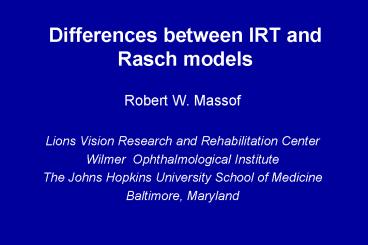Differences between IRT and Rasch models PowerPoint PPT Presentation
1 / 22
Title: Differences between IRT and Rasch models
1
Differences between IRT and Rasch models
- Robert W. Massof
- Lions Vision Research and Rehabilitation Center
- Wilmer Ophthalmological Institute
- The Johns Hopkins University School of Medicine
- Baltimore, Maryland
2
Disclaimers
- Not history Does not purport to explain how
models were developed - Not new Uses basic Thurstonian and
psychophysical principles - Not threatening Does not challenge accepted
beliefs - Not generalizable At current stage of
development, applies to rating scales and other
surrogate measures
3
General measurement theory
- For a given trial with a given person, we wish to
measure the magnitude of the latent stochastic
decision variable d - d is distributed across trials within a person
according to density f(d) and has an expected
value m and variance sd2
m
sd
4
Conjoint Variable
Rasch
IRT
5
General measurement theory
- Person constructs ordered response thresholds,
tx,to partition the latent decision variable into
concatenated intervals - Intervals need not be equal
t2
t1
t3
6
General measurement theory
- Within a person, response thresholds are
stochastic with density across trials of g(tx) - Expected value of response threshold for category
x is tx and the variance is sx2
7
Measurement decision rule
Person assigns category x to d if
t1, t2, , tx lt d lt tx1, , tm-1, tm
8
Express variables on each trial as expected
values plus residuals
- tx tx rx
- d m rd
9
Measurement decision rule
Assign category x to d if
t1, t2, , tx lt d lt tx1, , tm-1, tm
t1r1, , txrx lt m rdlt tx1rx1, ,tmrm
tx tx rx
d µ rd
10
Measurement decision rule
Assign category x to d if
t1, t2, , tx lt d lt tx1, , tm-1, tm
t1r1, , txrx lt m rdlt tx1rx1, ,tmrm
t1-r(1), , tx-r(x) lt m lt tx1-r(x1), ,tm-r(m)
r(x) rd - rx
11
Measurement decision rule
Assign category x to d if
t1, t2, , tx lt d lt tx1, , tm-1, tm
t1r1, , txrx lt m rdlt tx1rx1, ,tmrm
t1-r(1),.., tx-r(x) lt m lt tx1-r(x1),..,tm-r(m)
t1-r(1)-m,..,tx-r(x)-m lt 0lt tx1-r(x1)-m,..,tm-r(
m)-m
12
- The only random variables in the decision rule
are the combined residuals r(1),,r(x),r(x1),,r(
m) - The joint density function is
- This function has a covariance matrix that
describes the variance of each of the combined
residuals and the correlations between each pair
13
- The probability of satisfying the decision rule
for category x is the cumulative joint
probability - The probability of responding with category x
must be conditioned on the limits of the decision
rule
14
Comparison of models
tx1 tx (interval x) sx12 sx2 2?x sx1
sx sx2 sx12 2 sx2(1 ?x)
- Rasch rating scale model (Andrich, 1978)
- rx 0
- Vx (interval) 2sx2
- IRT rating scale model (Samejima, 1969)
- rx 1
- Vx (interval) 0
15
- For the Samejima IRT model,
- s1s2sxsmsr r12r13r1xrmx1.0,
therefore - r(1)r(2)r(x)r(m)r , and
- so
16
Samejima model
17
- For Andrichs version of the Rasch model
r12r13r1xrmx0, therefore - and
18
(No Transcript)
19
Andrich model
20
Two classes of rating scale model
- Samejima (IRT)
- Uncertain trait
- Fixed thresholds
- Interval sizes fixed
- Andrich (Rasch)
- Fixed trait
- Uncertain thresholds
- Interval sizes variable
21
Dichotomous responses
- Single threshold
- Cannot distinguish between uncertain trait and
uncertain threshold - Rasch and IRT models identical
22
But what about the discrimination index?
- That is another story.

